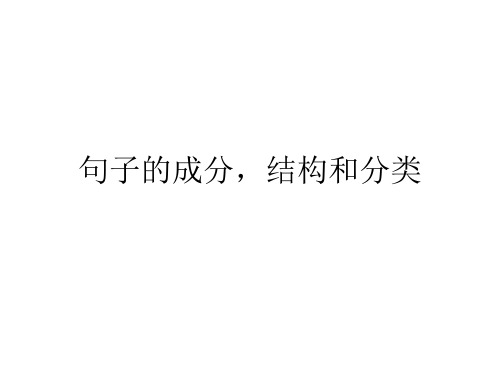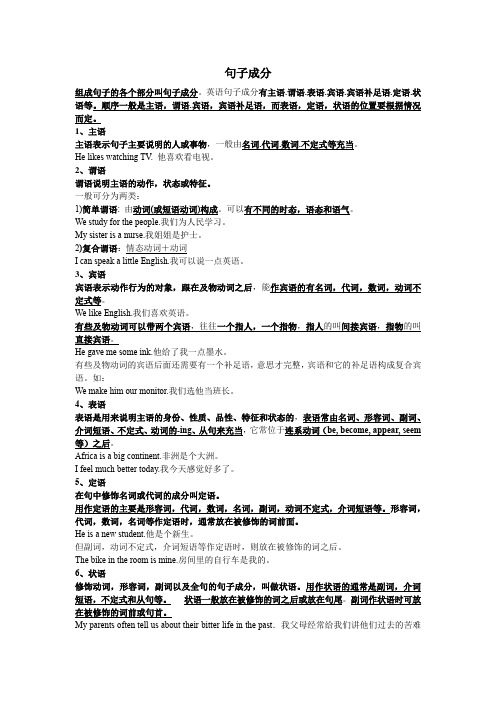句子成分和句子结构
- 格式:doc
- 大小:108.50 KB
- 文档页数:14



第二讲句子成分和句子结构一:句子成分句子是按照一定的语法规律组成的,表达一个完整的意义。
一个句子一般由两部分构成,即主语部分和谓语部分,这两部分也叫做句子的主要成分。
句子的次要成分包括宾语,定语,状语,表语等。
句子成分是句子中起一定功能的组成部分。
1、主语:是一句的主体,是全句述说的对象,常用名词,数词或代词担任,一般放于句首。
如:Students study. (学生学习。
)We are friends. (我们是朋友)这两句话中单词students是个名词,we是代词,它们在句中做主语。
充当主语的形式:1)名词2)代词3)数词4)动词-ing形式5)不定式6)名词短语7)名词从句等。
2、谓语:是对主语加以陈述,表示主语的行为或状态,常用动词或者动词词组担任,放在主语的后面。
如:Students study. (学生学习。
)We are friends. (我们是朋友)这两句话中单词study和are都是动词,study叫做实意动词,are叫做be动词,它们在句中作谓语。
谓语形式:动词(英语句子的灵魂)。
3、宾语:用来表示行为的对象或内容,常由名词或者代词担任。
放在及物动词或者介词之后。
如:I play with him. (我和他一起玩。
)I hate mouse. (我讨厌老鼠。
)这两句话中单词mouse是名词,单词him是代词,它们在句中作宾语。
充当宾语形式:1)名词2)代词3)名词短语4)-ing形式5)数词6)不定式7)名词从句等。
4、定语:用来修饰名词的成分,常用形容词或者相当于形容词的短语或从句担任。
形容词放在名词之前,相当于形容词的短语或从句放在名词的后面。
如:This is a red sun.(这是个红太阳。
)He is a tall boy.(他是个高个子男孩。
)The girl behind me is my sister. (我后面的那个女孩是我的姐姐。
)前两句话中单词red和tall都是形容词,它们作定语。

句子成分组成句子的各个部分叫句子成分。
英语句子成分有主语.谓语.表语.宾语.宾语补足语.定语.状语等。
顺序一般是主语,谓语.宾语,宾语补足语,而表语,定语,状语的位置要根据情况而定。
1、主语主语表示句子主要说明的人或事物,一般由名词.代词.数词.不定式等充当。
He likes watching TV. 他喜欢看电视。
2、谓语谓语说明主语的动作,状态或特征。
一般可分为两类:1)简单谓语: 由动词(或短语动词)构成。
可以有不同的时态,语态和语气。
We study for the people.我们为人民学习。
My sister is a nurse.我姐姐是护士。
2)复合谓语:情态动词+动词I can speak a little English.我可以说一点英语。
3、宾语宾语表示动作行为的对象,跟在及物动词之后,能作宾语的有名词,代词,数词,动词不定式等。
We like English.我们喜欢英语。
有些及物动词可以带两个宾语,往往一个指人,一个指物,指人的叫间接宾语,指物的叫直接宾语。
He gave me some ink.他给了我一点墨水。
有些及物动词的宾语后面还需要有一个补足语,意思才完整,宾语和它的补足语构成复合宾语。
如:We make him our monitor.我们选他当班长。
4、表语表语是用来说明主语的身份、性质、品性、特征和状态的,表语常由名词、形容词、副词、介词短语、不定式、动词的-ing、从句来充当,它常位于连系动词(be, become, appear, seem 等)之后。
Africa is a big continent.非洲是个大洲。
I feel much better today.我今天感觉好多了。
5、定语在句中修饰名词或代词的成分叫定语。
用作定语的主要是形容词,代词,数词,名词,副词,动词不定式,介词短语等。
形容词,代词,数词,名词等作定语时,通常放在被修饰的词前面。


七大句子成分与五大基本句型的结构分析引言句子是语言表达的基本单位,句子的结构通过不同的句子成分和句型构成。
理解句子成分和句型的结构对于提高语言表达的准确性和流畅性至关重要。
本文将对七大句子成分和五大基本句型的结构进行分析和解释。
七大句子成分句子成分是指构成句子的各个要素,可以分为以下七大成分:1. 主语:句子中谓语动作的执行者或所指对象。
2. 谓语:表达动作、状态或存在的核心词。
3. 宾语:接受谓语动作的对象或受事者。
4. 定语:对主语或宾语进行修饰或限定的成分。
5. 状语:对谓语进行修饰或限定的成分。
6. 补语:补充说明主语或宾语的成分。
7. 状语从句:对整个句子或其中一部分进行补充说明的句子。
五大基本句型句型是句子的基本结构模式,可以分为以下五大基本句型:1. S + V:主语 + 谓语。
例如:"他工作"。
2. S + V + O:主语 + 谓语 + 宾语。
例如:"我喜欢你"。
3. S + V + C:主语 + 谓语 + 补语。
例如:"她是医生"。
4. S + V + IO + DO:主语 + 谓语 + 间接宾语 + 直接宾语。
例如:"他给我一本书"。
5. S + V + O + OC:主语 + 谓语 + 宾语 + 宾语补足语。
例如:"我们选她为队长"。
结论通过了解七大句子成分和五大基本句型的结构,我们能够更好地理解和运用句子,提高语言表达的准确性和流畅性。
对于学习语言或提升写作能力的人来说,掌握句子成分和句型结构是非常重要的一步。
希望本文对您有所帮助。
句子成分一.主语(subject): 句子说明的人或事物。
1.请找出下列句子的主语并指出什么(词,短语或句子)可以充当主语。
The sun rises in the east. (名词)He likes dancing. (代词)Twenty years is a short time in history. (数词)Seeing is believing. (动名词)To see is to believe. (不定式)What he needs is a book. (主语从句)It is very clear that the elephant is round and tall like a tree.(It形式主语,主语从句是真正主语)常见错误分析2:动词及其短语在作句子的主语时,只能使用其to do 或doing 的形式。
其中不定式强调具体的某一次的动作,-ing 强调经常发生的动作。
改错:1.play computer games does no good to us.2.Have a walk in the street is her hobby.3.Go home at once is his decision4.Make more friends will do good to us.5.I’m like computer very much.6.The story was happening the year before last.二.宾语:1.动作的承受者-----动宾请找出下列句子的宾语并指出什么可以充当宾语。
I like China. (名词)He hates you. (代词)How many do you need? We need two. (数词)I enjoy working with you. (动名词)I hope to see you again. (不定式)Did you write down what he said? (宾语从句)2.介词后的名词、代词和动名词-----介宾Are you afraid of the snake/me/fighting?3.双宾语-----间宾(指人)和直宾(指物)He gave me a book yesterday.常见错误分析1:介词后跟宾语时,必须为:名词、代词、ing 或wh型的连接词引导的从句。
句子成份和句子结构——By Yang De Rui 一、句子成份英语句子成分有主语,谓语,宾语,表语,定语,状语,宾语补足语等。
顺序一般是主语,谓语,宾语,宾语补足语,而表语,定语,状语的位置要根据情况而定。
1、主语:表示句子主要说明或描述的对象,一般位于句首。
主语可由名词、代词、数词、不定式、动名词、名词化的形容词和主语从句等表示。
例如:My sister is a teacher.(名词)我的姐姐是老师。
We often speak English in class.(代词)我们经常在课上讲英语。
One-third of the students in this class are girls.(数词)这个班三分之一的学生是女生。
思考:哪些词不能充当主语?我们在学习中常犯哪些错误?该怎么处理?2、谓语:谓语说明主语的动作,状态或特征。
可以有不同的时态,语态和语气。
思考1:哪些词不能充当谓语?1)简单谓语:she works in a hospital. 她在一家医院工作。
(动作)思考2:简单谓语有哪种形式?我们常出现哪些错误?2)复合谓语:I can speak a little English. 我会说一点英语。
We are reading books. 我们正在读书。
He has gone to Beijing.他已经去北京了。
3、表语: 它位于系动词(比如be)之后,说明主语身份,特征,属性或状态。
My sister is a teacher. (我的姐姐是老师。
)The weather has turned cold.(天气已经变冷了。
)系动词:是用来帮助说明主语的动词,不能单独用作谓语,其后必须跟表语,如:be, become, turn, look, go等。
4、宾语: 宾语表示动作行为支配的对象,跟在及物动词之后。
We like English. 我喜欢英语。
They helped the old with their housework yesterday.(名词化形容词)有些及物动词可以带两个宾语,往往一个指人,一个指物,指人的叫间接宾语,指物的叫直接宾语。
句子成分和结构
1. 嘿,句子成分就像搭积木,主谓宾定状补各有各的位置呢,就好比我做蛋糕,鸡蛋面粉糖都得分开放好呀。
2. 句子结构就像盖房子,得有稳固的框架,不然会摇摇欲坠,这和我搭乐高积木一个道理,结构不好就容易散架。
3. 主啊谓啊的,就像我每天吃饭睡觉一样自然平常,是句子的基本组成部分呢。
4. 定语就像给句子化个妆,让它更好看些,就如同我出门前精心挑选衣服打扮一样。
5. 状语就像是给句子加上一些具体的情境,跟我讲故事时描述周围环境差不多。
6. 补语呢,好像是给句子打个补丁,让它更完善,就像我裤子破了要补一块一样。
7. 分析句子成分和结构有时候挺头疼的,就像我解一道很难的数学题一样。
8. 不过呢,搞懂了句子成分和结构,就像我掌握了一项厉害的技能,应用起来就得心应手咯,比如我做手工时熟练地使用各种工具。
句子成分和句子结构----认识英语句子的构成一、句子成分组成句子的各个部分叫做句子成分。
句子成分主要有主语、谓语、宾语、同位语、定语、状语、补足语、呼语和插入语等。
构成句子的主要部分是主语和谓语。
表语、宾语和补足语是谓语的组成部分。
其他成分如定语、状语、同位语是句子的次要成分。
1.主语主语是谓语动作或状态的执行者,指的是“谁”或“什么事”。
常用作主语的词类有:名词(短语)、代词、数词、名词化的形容词,不定式(短语)、动名词(短语)和从句。
George is a born leader. (名词)Nobody knew what had happened. (代词)Two of us will attend the conference tomorrow. (数词)The young are always willing to accept new things. (名词化的形容词)To go the bed early and to get up early is a good habit. (不定式短语)Losing his new MP4 made Tom very sad. (动名词短语)What we can’t get seems better than what we have. (名词性从句)2.谓语谓语用来描述主语的行为动作或所处的状态,说的是“做什么”或“怎么样”,谓语动词有人称、数、时态和语态等的变化。
Father cooks very well.My sister has worked in the company for five years.Our school is becoming more beautiful.The World Expo is well organized.3.宾语宾语是动作的承受者,指的是“做”的内容。
英语有单宾语、双宾语、复合宾语、同源宾语等。
双宾语又分为直接宾语和间接宾语。
凡能做主语的词、短语或从句都可以作宾语。
(1)单宾语(宾语)可以作宾语的成分主要有名词(短语)、代词、数词、名词化的形容词、名词化的分词、不定式(短语)、动名词(短语)、从句等。
I can hardly hear the radio. Would you please turn it up? (名词、代词)If you put 5 and 7 together, you’ll get 12, little Tom. (代词)We should help the poor. (名词化的形容词)Remember to tell him to come. (不定式)Please stop making noise. (动名词)Do you understand what I mean? (名词性从句)(2)双宾语双宾语指动词后面接指人和物的两个宾语。
指人的宾语叫间接宾语,指物的宾语叫直接宾语。
其结构为:主语+ 及物动词(短语)+ sb. + sth.Please tell me how the accident came about.The teacher asked me a question too difficult to answer.(3)同源宾语少数不及物动词后面能跟一个特定的名词作宾语,这个名词和前面的动词在词根上相同的或者在意义上是相近的,这样的宾语就叫做同源宾语。
同源宾语前面常有修饰语。
laugh a good laugh 大笑blow a heavy blow 沉重的一击smile a sweet smile 甜甜的微笑dream a terrible dream 做了一个恶梦die a brave death 死得英勇live a happy life 过着幸福的生活4.表语表语与前面的系动词一起构成谓语,用来说明主语的特征、类属、状态、身份等。
His father is an experienced teacher. (名词)She is over fifty, but she doesn’t look it. (名词、代词)These students are careful while others are careless. (形容词)The class meeting was over at last. (副词)Be quiet; they are at work now. (介词短语)His hobby is collecting foreign stamps. (动名词短语)My wish is to become a doctor in the future. (不定式短语)The news of her success is really exciting. (现在分词)(已形容词化)That is where your mistakes are. (名词性从句)5.定语定语是用来描述名词或代词的修饰语,它常和名词构成名词短语。
定语可分为前置定语和后置定语两种。
(1)前置定语可以充当前置定语的有形容词、代词、数词、名词和名词所有格、动词的-ing形式、动词的-ed形式等。
Many people have helped with (canned) food. (过去分词)Open (your) mouth and put out (your) tongue. (代词的所有格)She cut the cake into (two) pieces. (数词)I want to buy some (coffee) cups. (名词)Put the child in the (sleeping) bag. (动名词)You should adapt to the (changing) situation. (现在分词)(2)后置定语可以充当后置定语的有形容词,副词,介词短语,不定式(短语),动词的-ing短语,动词的-ed短语,从句等。
All people (present at the party) were his supporters. (形容词短语)I have got something (interesting) to tell every one of you. (形容词)The buildings (around) were badly damaged. (副词)The books (on the top shelf) were just bought. (介词短语)Let’s try another way (to do this). (不定式)There is a gentleman (asking to see you). (现在分词短语)Most of the people (invited to the party) were famous scientists. (过去分词)He lost his new pen (that was bought last week). (定语从句)6. 同位语在句中对某一成分作进一步的解释,说明,并且与其在语法上处于同等地位的句子成分叫做同位语。
同位语常放在被说明的名词或代词的后面,可以用作同位语的有名词,代词,数词和从句等。
The English Department has two foreign teachers, an Australian and an American. (名词) This term we each bought an e-dictionary. (代词)They three are all three-good students. (数词)The news that we are having a holiday is true. (同位语从句)7. 状语状语是用来修饰动词,形容词,副词或句子的一种句子成分。
它可以表示时间,地点,方式,程度,原因,目的,结果,条件和让步等关系。
可以充当状语的有副词,介词短语,不定式,分词,,形容词,名词和从句。
[At the news], the mother stood [there], [greatly surprised]. (介词短语、副词、形容词)They held the English party [in the open air]. (介词短语)Just wait [a moment]; I am dressing myself. (名词)[To hear more clearly], she sat in the front of the classroom. (不定式)[Finishing all her homework], she surfed the Internet for a while. (现在分词短语)[Seen from the top of the hill], the small city looks more beautiful. (过去分词短语)Don’t leave here [until you work out the math problem]. (时间状语从句)8. 补足语补足语用来说明宾语或主语的性质,状态等的一种句子成分。
名词,形容词,副词,介词短语,现在分词,过去分词,不定式等皆可以作补足语。
I saw nobody <in> so I left. (副词)You’d better keep the books <standing> on the desk. (现在分词)The mother didn’t allow her daughter <to go out> alone at night. (不定式)These things should be kept <in the box>. (介词短语)The coming exam keeps me <busy with my lessons>. (形容词短语)He was elected <chairman> of the company. (名词)When he arrived, he found all the people <gone>. (过去分词)9. 独立成分与句子没有关系或关系不大,独立于句子之外的成分称为独立成分。
感叹词,呼语和插入语是英语中常见的三种独立成分。
(1)感叹词感叹词作独立成分多置于句首。
Well, let’s end the discussion!There, there! Never mind. It’s nothing serious at all.(2) 呼语呼语多独立成分可置于句首,句中或句末。